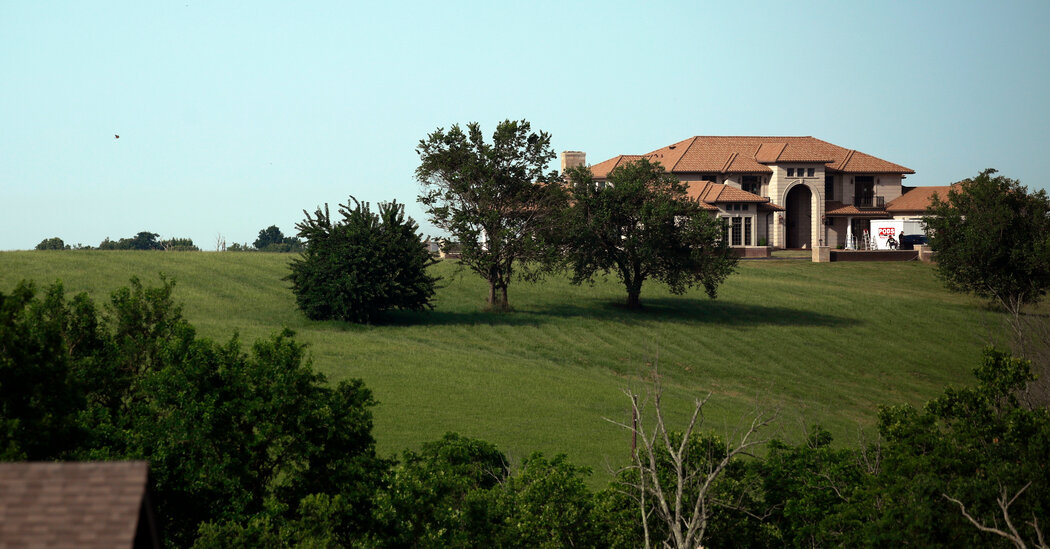
To hear more audio stories from publications like The New York Times, download Audm for iPhone or Android.
RICHMOND, Ky. — The doorbell rang in the night, waking C. Wesley Morgan. He rolled out of bed and walked into the foyer, looking through the arched glass entryway into the dark. Nobody. These phantom rings had been happening lately; most likely there was a short somewhere in the system. The rain didn’t help. He went back to bed.
Minutes later, he awoke to the sound of a crash, then the rattle of gunfire. It was coming from upstairs, where his daughter Jordan was sleeping. Mr. Morgan rushed to the French doors leading out of his bedroom, opening them to see a man in a mask and carrying an AR-15 walking down the stairway.
The man looked blankly at Mr. Morgan, who had time to shout one word: “Why?”
What could drive a man to try to kill a family he had never met? The explanation Mr. Morgan had been given for the attack on that early February morning — mental illness — he found almost insultingly weak. He was certain that it had to have been a deliberate part of some larger plot. For more than a decade, he had been vigilant about such dangers, convinced that the country was hurtling toward civil war. He put millions of dollars behind his fears, building a fortress in the countryside. He knew that some thought he was paranoid.
A dozen years later, a sense of impending breakdown has spread beyond the fringes, taking hold across a country that can at times feel dangerously unhinged. Pandemic, lockdowns, fire and flood, ubiquitous rage and shocking violence: A deadly rampage can suddenly break out in the big-city suburbs or in a remote little town, at work, at the grocery store, at school or even at home. Mr. Morgan thought he had prepared for whatever catastrophes might come, diligently constructing a place that could guarantee his family’s safety. Now he wonders if he had invited the catastrophe that followed.
On a warm evening at a public campground in central Kentucky, Mr. Morgan, 71, sat in a folding chair, watching his wife, Lindsey, and 14-year-old daughter, Sydney, take a walk among the campers and R.V.s. He was spending his nights in agony over Jordan’s death, he said. She had been shot at least 11 times in her bed. Just thinking about it, he said, was like being strangled.
His days were spent overseeing repairs to his bullet-riddled house and talking to potential buyers.
He had built the house in the Obama years, when he was convinced society was on the verge of collapse. Here his family could live in secluded comfort, and if the social fabric truly tore apart, as he expected it would, they could wait out the chaos in an abundantly stocked underground bunker. Now he couldn’t wait to be rid of it.
“Our life hasn’t been right since I started construction on that son of a bitch.”
A $6.5 million estate was a far cry from Mr. Morgan’s childhood. He grew up in the mountains of eastern Kentucky, where his father drove a small-town taxi and where, he said, he spent his early years without indoor plumbing.
He left the state as a young man to work as a federal investigator, uncovering illicit gun markets and underground gambling rings. But his father pressed him to come back home and put down roots.
So in 1982, he took out a loan to buy a liquor store in Richmond, a small city about a half-hour southeast of Lexington. Southern Kentucky in the 1980s and 1990s was still a desert of dry counties, and Richmond was the closest oasis for miles. Mr. Morgan eventually opened Liquor World, a giant alcohol emporium in Richmond, where, he said, “we were doing over a million a month.”
He married and had a daughter, Jordan. He divorced, married again, and Sydney was born. He went to Ireland to watch horse races, took the family to Paris, bought a boat. And in 2009, he got to work on the house.
“My vision was that I was building a place I was going to die in,” he said. “The finest everything. I spared no expense.”
More True Crime Stories
On 200 acres of Kentucky meadow just outside of Richmond, his vision became a 14,300-square-foot reality. Nine bedrooms, three kitchens, a six-car garage, a steam room, a saltwater pool — the front entryway alone cost $75,000.
“My feelings were that we were going to have civil unrest because there was so much going on with Obama,” Mr. Morgan said. He believed that people were going to rise up against the attempts to overhaul health care and restrict guns, and that societal collapse would soon follow. He envisioned “roving bands of gangs” hunting for food and necessities in the aftermath. He bought riot gear, bulletproof vests and a small arsenal of firearms, so that “if you had to engage a band of marauders, you would have a chance to save your family.”
The keystone of his survival plan was what lay underneath: a shelter 26 feet underground, beneath a 39-inch solid ceiling. It contains 2,000 square feet of bedrooms and common space along with a stocked food pantry, an air filtration system and two escape tunnels, one of them 100 feet long. The company that installed the shelter suggested that Mr. Morgan keep quiet about it, because “if anything ever happened, there’d be people that try to take the bunker.”
But even as he built his fortified sanctuary, politics in Kentucky were shifting, becoming more favorable for those with the kind of hard-right convictions that Mr. Morgan held. Jordan, who had become an ambitious and outspoken conservative herself, landed a job out of law school in the new gubernatorial administration of Matt Bevin, the firebrand Republican. Mr. Morgan decided to run for the Kentucky House of Representatives and in 2016 became the first Republican in decades to win his district.
Within days of taking office, he had become a lightning rod for criticism and derision. Good government groups expressed shock when Mr. Morgan proposed a slew of bills that would help the retail liquor business. Democratic lawmakers lambasted his measures allowing teachers to carry guns and granting immunity to motorists who unintentionally hit protesters blocking traffic.
But Mr. Morgan’s bitterest ire from his time in politics was reserved for his fellow Republicans. He blamed them for his negative press coverage, complained that the party did little to support his legislative proposals and publicly blasted Republican leaders who were implicated in scandal. When Mr. Morgan ran for re-election, another Republican challenged him in the primary, and won.
The whole experience convinced Mr. Morgan that he was the target of a corrupt power structure. Lauding the “patriots” of QAnon in Facebook posts, he mounted a quixotic primary campaign against Senator Mitch McConnell, whom he condemned as a “deep-state traitor.” When the primary was over, Mr. Morgan was done with Kentucky.
He listed his house on Zillow — “perfect for grand scale entertaining and family living,” the listing read, with “the highlight of the property” being “a $3 Million, 2,000 sq. ft. Nuclear/Biological/Chemical Fallout Shelter.” He assumed the listing would be seen only by buyers interested in a $6.5 million property. But it went viral.
“A cult compound,” one commenter wrote online; “getting mole people vibes,” added another. Strangers drove out to the house to gawk, and articles were written about it on real estate websites and in the state papers.
Jordan, 32, told her father she had come to feel unsafe at the house. In February of this year, she was hired by a law firm in Lexington and planned to move as soon as possible to an apartment in the city. “She must have sensed that she was being watched,” he said.
Someone had been watching, marking the house’s entry points and taking detailed notes on the family’s movements. Early on the morning of Feb. 22, prosecutors say, the watcher, Shannon V. Gilday, a 23-year-old former soldier who lived in the Cincinnati suburbs, climbed up to a second-floor balcony and began his attack.
“He stood and looked at me without any emotions, like he was programmed,” Mr. Morgan said of the moment he first encountered Mr. Gilday in the foyer. At that point, Jordan was dead.
Now Mr. Morgan was the target.
Bleeding from his arms, Mr. Morgan crawled across the bedroom carpet, dragging himself around to the other side of his bed. His wife was gone, having rushed into Sydney’s bedroom next door. Mr. Morgan took a loaded pistol out the drawer of his nightstand. When the French doors opened, he emptied the gun.
“I shot 12 times,” he said. “I was out of bullets. But that did something to him. He turned and shot twice through Sydney’s door, and then he went into the bathroom.”
Mr. Morgan quickly considered his other guns — another pistol in the drawer, the 12-gauge shotgun in the closet, the AR-15 in the guest bedroom — but saw his cellphone on the nightstand. He grabbed it and called the police.
“See, that’s another thing I hate myself for,” he said. If he had just gotten another gun, he could have killed the intruder there and then.
Instead the attacker hurried out into the night. The authorities arrived soon after and Mr. Morgan found himself in an ambulance unaware of what had happened to Jordan, Sydney, Lindsey or the man who had tried to kill them all.
A few days later, the police found Mr. Gilday, walking before dawn along an Interstate exit a couple of miles from the Morgan home. Detective Cameron Allen of the Kentucky State Police interviewed him for three hours following the arrest; Mr. Gilday, he said, confessed. The police already had an idea of his motive. According to a search warrant application, Mr. Gilday had researched a number of houses in Kentucky before settling on the Morgans’. All of them shared one feature: a bunker.
“His belief at the time,” Detective Allen said at a March hearing, “was that given the current political environment in our country, as well as in the world at this time, and given events that had taken place throughout the world, he wanted to access this bunker, so that he could secure it for himself and his family and friends.”
In the weeks after the shooting, news about Mr. Gilday trickled out. A friend told the police that he had “a history of psychotic problems.” Neighbors described strange recent encounters in which he talked about the Russian invasion of Ukraine.
Mr. Gilday’s mother said in a statement on Facebook that her son had “not been of sound mind the last couple of weeks, distraught with the certainty a nuclear war is imminent.”
“He spoke of building a bunker and the C.I.A. following him,” she continued. “I tried to get him psychiatric help but to no avail.”
Mr. Gilday, who is being held in the local detention center, was charged with murder and attempted murder for the attack on the Morgans. In May, his lawyer tried to enter a plea of guilty but mentally ill. A hearing is scheduled for Friday.
Mr. Morgan did not buy any of this. The attack was so meticulously planned. How could that be the work of an insane person? he asked.
He instead speculated about political forces that might have it in for him and his family. He talked about hired assassins and past C.I.A. experiments with brainwashing, and suggested that a violent attack on the home of a Second Amendment champion like himself had all the signs of an operation to justify more gun control.
“I just think that I was chosen to be a false flag,” he said.
This made a lot more sense to him than murdering a family to get to their bunker.
Still, he could not shake the thought that his decision to enter politics had been his fatal error. If he had kept out of public life, neither his politics nor his bunker would have been so widely known. The grief and the guilt were almost unbearable. Parents have one duty above all, he said, and that was to keep their children safe.
“I’m the one who should have died, not Jordan,” he said. “I’m the one who made the mistakes. Jordan didn’t make them. My baby has paid for the sins of her father.”
As the dusk settled over the campground, Mr. Morgan got up from his chair and walked over to a luxury black-and-gold motor coach parked at the campsite. This was the family home now. Their future lay on the road, home-schooling Sydney on their travels, avoiding crowded areas, never putting down roots.
“I just can’t do this anymore,” Mr. Morgan said. When he began building the bunker, Jordan was around 20, with a bright future ahead of her, and Sydney was a toddler. Now Sydney is a teenager and Jordan is dead. With all the heartache he was carrying, he was not sure how many more years he would be around himself.
“We may take this bus and go to Florida and then a tsunami comes in there and drowns us all,” he said. “I can’t worry about this anymore.”
The next day, the family left for Tennessee.
Kirsten Noyes contributed research.
Audio produced by Jack D’Isidoro.




